We all love those small green Coleman 1-lb Propane tanks but if you are a regular camper, you might be stuck with a garage full of empty bottles that you don’t know what to do with.
One solution is to connect your camping stove directly to a larger 20-lb refillable tank and stop using small tanks. This article will guide you on how to connect a camping stove to a big propane tank.
To connect your camping stove to a big propane tank, you need a high-pressure hose with a Type-1 connector at one end and a 1″ male threaded connector at the other. If your stove doesn’t have a built-in pressure regulator, you will need that too.
Although the conversion is simple by using a hose-adaptor kit (like this one), let’s go through the process step by step, while explaining each component required for the job.
Which camping stoves can you connect to a large propane tank?
This guide is for camping stoves and grills that run on portable 1lb propane tanks with threaded connectors (see picture below).
You can also convert any other camping equipment like a heater, lamp, etc with this guide.
The only requirement is that it should have the 1″ threaded connector shown below and run on propane.
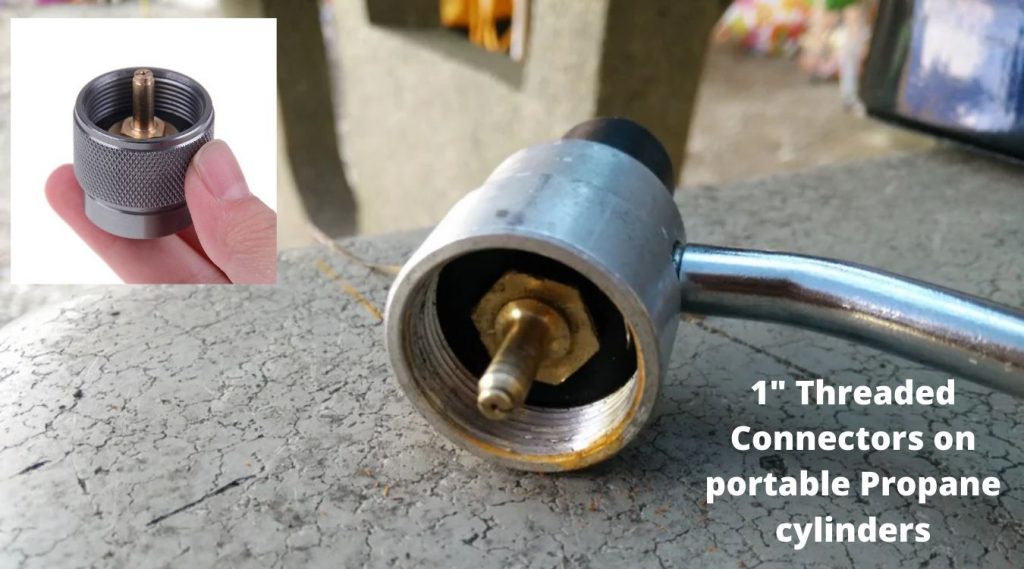
Note: This guide is not for converting your kitchen natural gas stove to propane. Read what happens if you use propane on a natural gas stove.
The most famous camping stoves and grills in this category are from Coleman. They come with single or two burners and run on portable 1lb green propane cylinders that have a threaded 1″ connector you can directly hook to your portable propane tank.
A few popular stoves are the Coleman Fold N Go, the Coleman Powerpack single burner stove, and the Coleman camping grill.
After converting following this guide, you can hook your camping stove or grill with any large propane tank with a Type-1 connector (see image below)
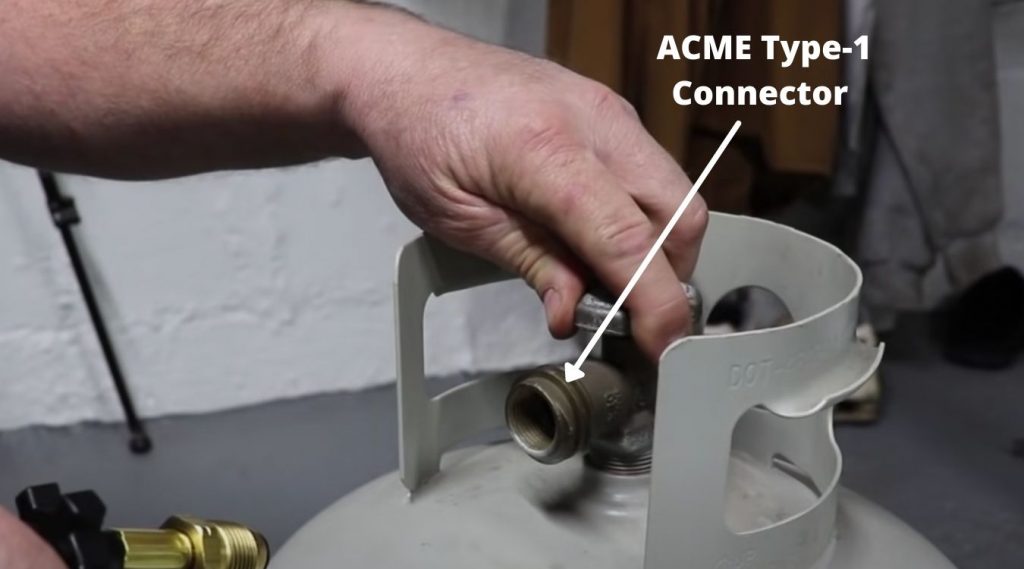
Connecting camping stove to big propane tank – requirements
To convert your camping stove to work on a big 15lb or 20lb refillable Propane tank, you will need one of the below conversion kits depending upon your stove and if it has a built-in pressure regulator.
- High-pressure hose with Type-1 Adapter without regulator [Link to buy]
- High-pressure hose with Type-1 Adapter with regulator [Link to buy]
As you can see, there are two main components in this conversion kit; the adaptor and the pressure regulator.
Let me briefly explain what they are so that you know which conversion kit you need to get.
High-Pressure hose with Type-1 Adapter
This is your main component to convert your camping stove to work with any large propane tank.
The camping stoves that connect with the 1lb small and portable propane cylinders have 1″ threaded connectors which you screw in your cylinder. On the other hand, the large propane tanks have ACME Type-1 connectors.
To connect these two different connectors, we need an adaptor. It is also advisable to keep the large propane tank as far away from the stove as possible.
That’s why the adaptor is mounted on the head of a few feet of long, high-pressure hoses making one piece of a conversion kit that connects the tank and the stove.
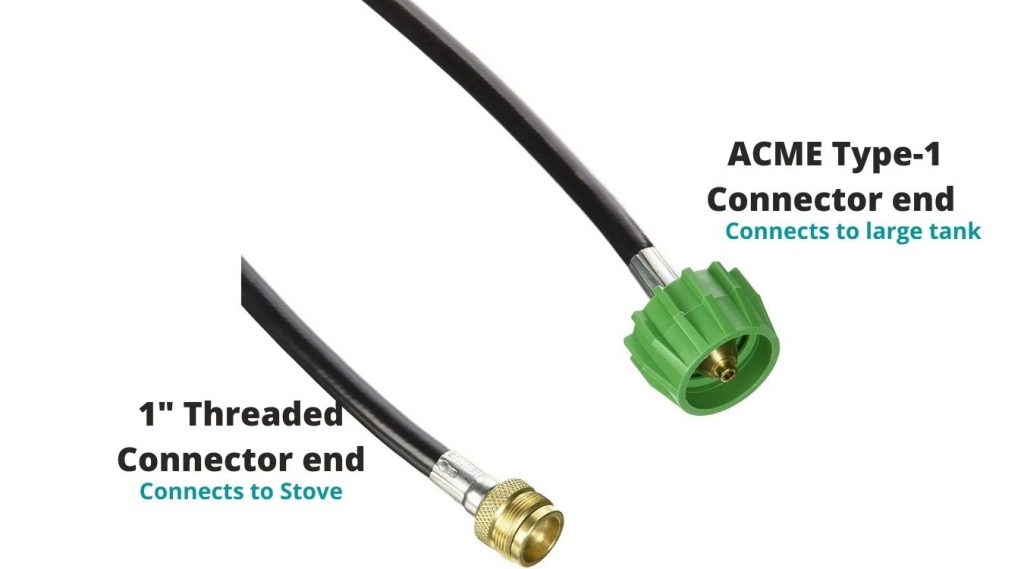
Pressure regulator
The pressure regulator is a component that makes sure your equipment (stove or grill) always gets a pressure suitable for optimum operation.
Most modern stoves and grills have built-in pressure regulators. In such a case, you don’t need to add an external one to your conversion setup.
Check your stove for a blob adjustable value. If you see one, it’s the pressure regulator. If you are not sure, you can check your stove’s manual and see if they have mentioned any pressure regulator.
Most Coleman stoves have pressure regulators attached to the externally protruded stiff hose where you connect the portable tank (see the picture below) so you don’t need any additional regulator.
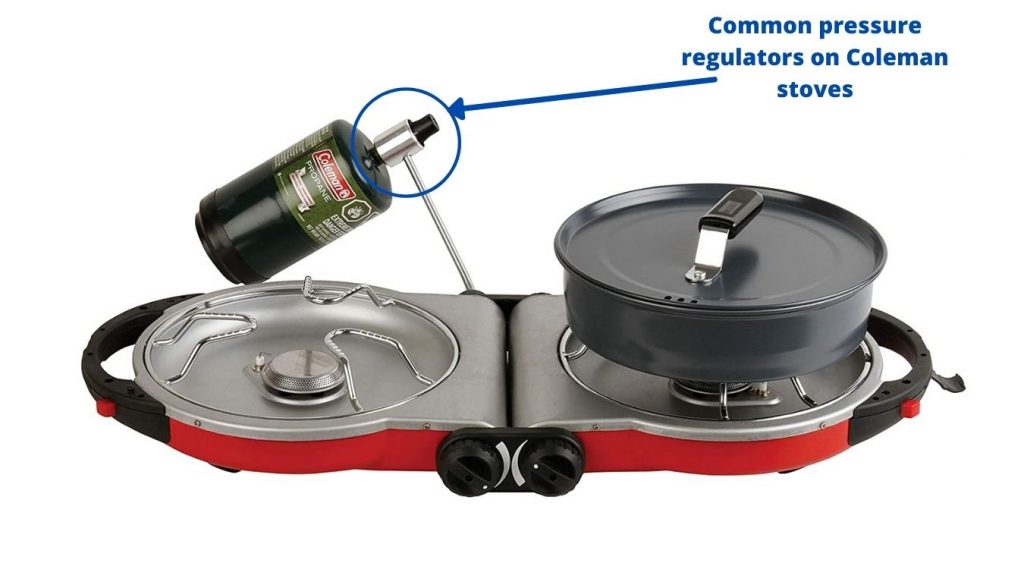
If your stove doesn’t have a regulator, you can get your high-pressure hose adaptor with a regulator at the end (like this one).
Just make sure the stove end of the hose has the right connector types w.r.t. your stove.
To summarize, if your stove or grill has a built-in pressure regulator, get the conversion kit without a regulator. Else, get the conversion kit with a pressure regulator.
Coleman stove propane adapter
Since Coleman is the common brand when it comes to camping stoves, you can find a Coleman stove propane adapter for a 20lb tank quite easily.
As mentioned above, the adapter will have a long hose with a 1″ threaded female connector at one end and an ACME Type-1 connector at the other end.
Since Coleman stoves and grills come with a built-in pressure regulator, you don’t need an additional one on the adapter hose.
You can get the Coleman propane tank adapter from any hardware store, Home Depot, or Amazon [link here].
How do you hook up a large propane tank to a camping stove?- step by step
Now that you have the correct conversion kit, it’s time to hook up your stove or grill to your large 20-lb tank.
Simply follow the steps below.
Shut off all the valves: First of all, make sure all the valves on your stove and your large propane tanks are tightly shut off. This is necessary to avoid any unintended gas leaks during the process.
1. Prepare the adaptor ends
Before you connect the connector ends to the stove and propane tank, it’s a good idea to clean the adaptor ends from any dirt or debris. As camping equipment, they spend a lot of time in the wild and sometimes, get dirty.
If you want a better seal you can wrap some Teflon tape on both ends. Teflon tape makes sure there is no gas leak by providing a good seal.
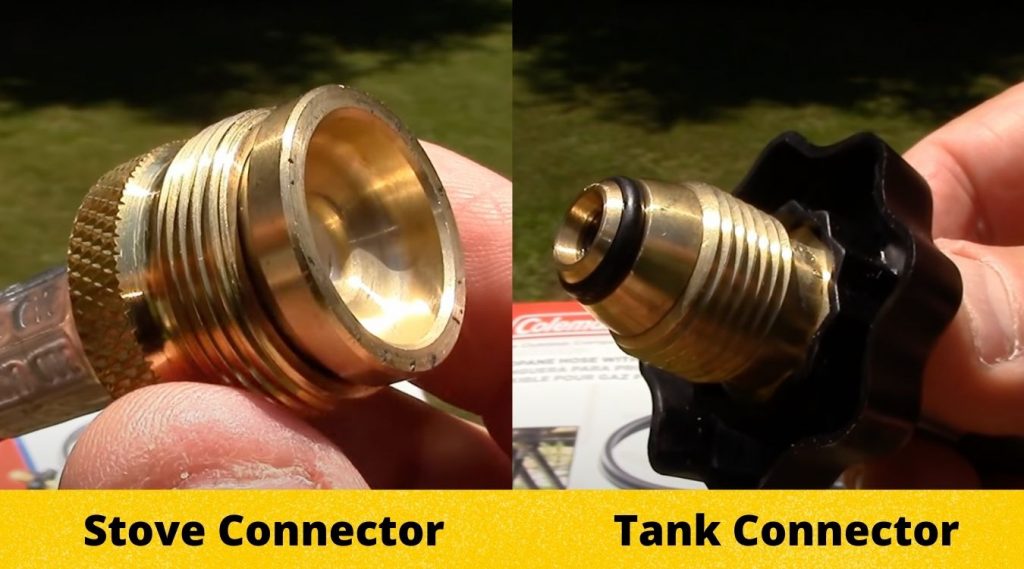
2. Connect the hose to the stove
Take the smaller end of the conversion kit and secure it to the stove by screwing in the threaded end. Hand-tighten the hose into the stove with the pressure regulator and it will be enough.
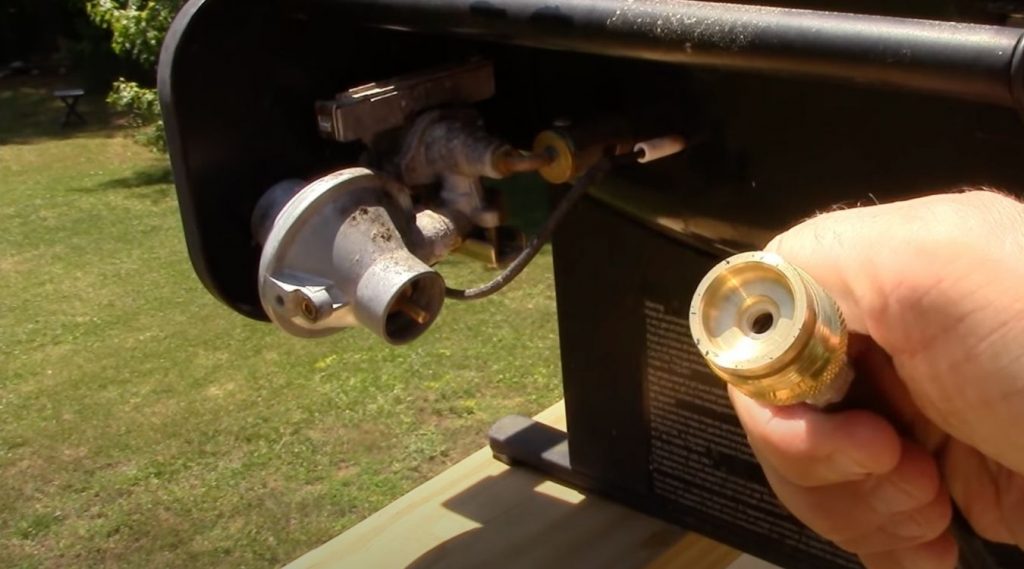
3. Connect the hose to the tank
Next, you have to connect the Type-1 connector to the large propane tank. Screw in the connector and turn it counterclockwise. Make sure you hand tighten it fully to avoid any gas leaks.
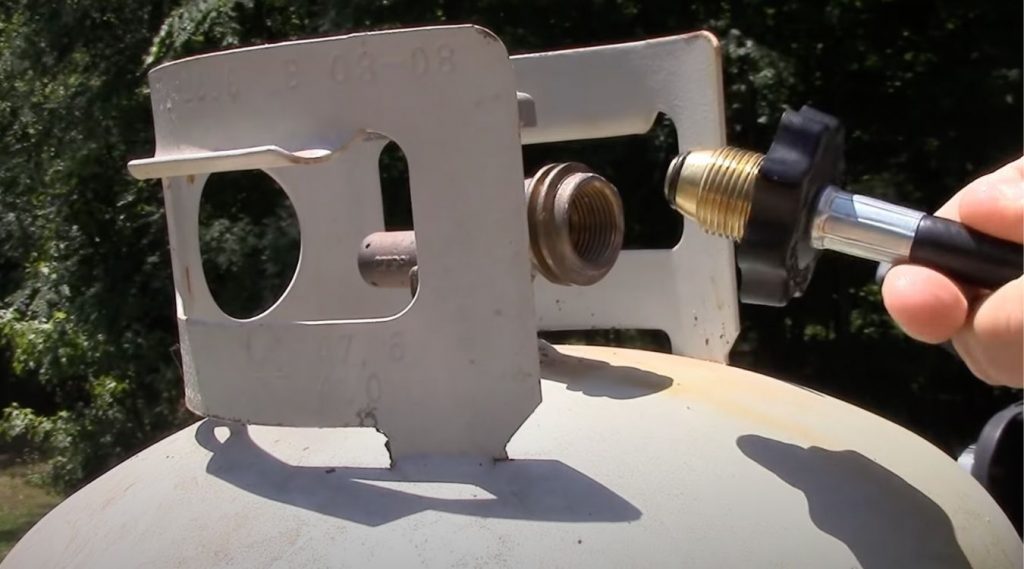
4. Perform soap bubble test
It is always a good idea to do a soap bubble test before turning your setup on.
To do this, make a soap solution and apply it to both the connector ends (stove and tank) and watch for any bubbles. If you see any bubbles, that means you have a gas leak.
Fix the leak and do the bubble soap test again before turning your stove on.
5. Open the tank valve
Open the valve of your large propane tank. You need to turn it slowly so that you don’t get too much flow at once.
Some pressure regulators come with an additional safety feature that trips and shuts off the valve if it detects too much flow.
That’s it! You have now successfully connected your camping stove to a large propane tank. You can now get rid of the portable 1lb propane cylinders and cook directly from your larger tank.
What are the advantages of using a larger propane tank?
Although the smaller portable 1lb propane tanks are more convenient and easy to carry, the larger 20lb propane tanks make more sense if you plan on cooking for a family or a group of people.
Small propane tanks can last only for 2 hours on a 2-burner stove while a large 20lb tank can last 8 times longer (20+ hours). So you end up spending less getting new cylinders and replacing empty ones.
The other major advantage is that after setting up your camping stove, you don’t have to walk anywhere to get the cylinder refilled/replaced. You will be better off with a 20-lb large tank if you don’t want to run out of camping stove propane every other hour.
Large tanks are more economical in the long run because you can refill and reuse them, versus buying a new portable tank every time.
Larger tanks are also more environmentally friendly. With small disposable tanks, you end up with an empty tank that you don’t know how to dispose of.
They eventually end up in landfills if not taken care of properly.
What are the disadvantages of using larger propane tanks?
The main disadvantage is that the large 20-lb tanks are not easy to carry. Although they have handles, it can be difficult for one person to carry them especially when full.
If you are backpacking, this becomes next to impossible to carry and you will have to live with the smaller more portable 1lb tank.
Also, the portable 1lb propane cylinders are easy to store at the campsite and don’t take up much room.
Larger 20lb tanks are bigger in size and harder to store than smaller tanks. Most people will end up putting them out in the sun which can end up with propane leaks or explosions.
How much does a large propane tank weigh?
Large propane tanks are not the most portable ones for camping. They weigh enough to make it impractical for a backpacking trip.
However, if you are camping out of your van or RV, you can carry any size you want depending on the duration of your trip and the number of campers you will be cooking for.
The below table gives the dimensions and weight of commonly available propane tank sizes.
| Propane Tank Size | Dimensions | Weight |
|---|---|---|
| 100 Pound | 15×48 x15 inches | 177 lb (filled) |
| 40 Pound | 12 x12 x29 inches | 68 lb (filled) |
| 30 Pound | 12 x12 x24 inches | 52 lb (filled) |
| 20 Pound | 12 x12x18 inches | 31 lb (filled) |
| 1 Pound (16.4Oz) | 8.6 x4 x3.88 inches | 1.13 lb (filled) |
Can you connect other camping equipment to a large propane tank?
Following this guide, you can connect any propane equipment that has a 1″ threaded connector that connects to the Type-1 connector found on all large propane tanks.
For example, you can connect a camping stove, bbq grill or even a lantern or camping heater. If it has a 1″ threaded end that fits into your larger tank, you are good to go.
Remember there are no valves in this setup so always do the soap bubble test before turning your equipment on for safety precautions.
FAQs
Can you connect a grill to a large propane tank?
Yes, you can. Buy a propane adapter kit from any store that sells camping equipment and supplies. Make sure the grill you buy has a 1″ male threaded end that can connect to the propane tank that has a Type-1 connector.
Can you connect a lantern to a large propane tank?
Yes, you can by using the same adapter kit that works for the grill.
Can you connect an RV refrigerator to a 20-lb tank?
You can connect your RV refrigerator to a 20-lb tank as well. An 8 cubic ft refrigerator can run for 280 hours on a 20-lb propane tank.
Is a 20-lb propane tank high or low pressure?
Propane is always stored in a liquid state at high pressure. A 20-lb propane tank can exert a pressure of 10 bars (145 PSI) on its wall at room temperature. So, yes a 20-lb propane tank is a high-pressure tank.
Recommended Camping Gears: I have compiled a list of my favourite camping gear in one place. The selection is based on my own personal experience using them for many years camping as well as feedback from fellow campers. Check them out on my Recommended Camping Gears page